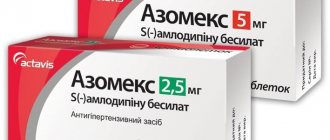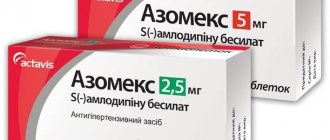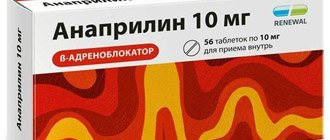Omacor
Omega-3 polyunsaturated fatty acids - eicosapentaenoic acid (EPA) and docosahexaenoic acid (DHA) - are classified as essential fatty acids (NEFA). Omacor is active against plasma lipids, reducing the concentration of triglycerides as a result of reducing the concentration of very low density lipoproteins (VLDL). In addition, it affects blood pressure and hemostasis. Omacor reduces the synthesis of triglycerides in the liver, since EPA and DHA are less active substrates for the enzymes responsible for the synthesis of triglycerides, and they inhibit the esterification of other fatty acids.
A decrease in triglyceride concentration is also facilitated by increased P-oxidation of fatty acids in liver peroxisomes, thereby reducing the amount of free fatty acids available for triglyceride synthesis. Inhibition of this synthesis reduces VLDL levels.
Omacor increases low-density lipoprotein (LDL) cholesterol levels in some patients with hypertriglyceridemia. The increase in high-density lipoprotein (HDL) cholesterol concentrations is minimal, significantly lower than after fibrates, and not consistent.
The duration of the lipid-lowering effect when taking Omacor for more than 1 year has not been studied. Otherwise, there is no convincing evidence that lowering triglyceride levels reduces the risk of coronary heart disease.
During therapy with Omacor, a decrease in the synthesis of thromboxane A2 and a slight increase in blood clotting time were observed. No significant effects on other coagulation factors were observed.
The results of the GISSI-Prevenzione clinical trial, obtained over 3.5 years of follow-up, showed a significant reduction in the relative risk of mortality from all causes, non-fatal myocardial infarction and non-fatal stroke by 15% ([2-26] p = 0.0226) in patients after recently suffered myocardial infarction, taking the drug Omacor 1 g per day.
Additionally, the relative risk of death due to cardiovascular disease, non-fatal myocardial infarction and non-fatal stroke was reduced by 20% ([5-32] p=0.0082). The results of another clinical trial, GISSI-Heart Failure, in which patients with chronic heart failure received Omacor 1 g per day for an average of 3.9 years, showed a reduction in the relative risk of mortality from all causes by 9% (p = 0.041), reduction in the relative risk of mortality from all causes and hospitalization due to cardiovascular pathologies by 8% (p = 0.009), reduction in the relative risk of primary hospitalization due to ventricular arrhythmias by 28% (p = 0.013).
Instructions for use of OMACOR®
Lipid-lowering drug. Contains omega-3 polyunsaturated fatty acids - eicosapentaenoic acid (EPA) and docosahexaenoic acid (DHA), which are essential fatty acids.
Omacor reduces the content of triglycerides as a result of a decrease in the concentration of VLDL, in addition, it affects hemostasis and blood pressure.
Omacor reduces triglyceride synthesis in the liver, since EPA and DHA are weak substrates for enzymes responsible for triglyceride synthesis and inhibit the esterification of other fatty acids.
Increased beta-oxidation of fatty acids in liver peroxisomes also helps reduce triglyceride levels by reducing the amount of free fatty acids involved in their synthesis. Inhibition of triglyceride synthesis reduces VLDL levels.
In some patients with hypertriglyceridemia, Omacor increases LDL-cholesterol levels. HDL-C levels increase only slightly, much less than after fibrates, and not permanently.
The long-term lipid-lowering effect (after use for more than 1 year) is unknown. Moreover, there is no significant evidence that lowering triglyceride levels reduces the risk of developing CAD.
During therapy with Omacor, there is a decrease in the formation of thromboxane A2 and a slight increase in bleeding time. There were no significant effects on other coagulation factors.
An open multicenter randomized study GISSI-Prevenzione was conducted in Italy. 11,324 patients who had recently suffered a myocardial infarction (<3 months) and were receiving recommended prophylactic treatment with a Mediterranean diet were randomized to receive Omacor (n=2836), vitamin E (n=2830), Omacor and vitamin E (n= 2830) and in the control group (n=2828). The results of observation for 3.5 years when using Omacor at a dose of 1 g / day showed a decrease in the combined indicator, which included overall mortality, non-fatal myocardial infarction and non-fatal stroke (compared to the control group, the relative risk decreased by 15% [2-26] p = 0.0226 in patients who took Omacor, and by 10% [1-18] p=0.0482 - in patients who took Omacor with or without vitamin E). There was a reduction in the second prespecified endpoint of cardiovascular mortality, nonfatal myocardial infarction, and nonfatal stroke (relative risk reduction by 20% [5-32] p = 0.0082 compared with the control group in patients receiving Omacor as monotherapy , and by 11% [1-20] p=0.0526 in patients taking Omacor with or without vitamin E). Secondary analyzes of each component of the primary endpoint showed significant reductions in all-cause and cardiovascular mortality but no reduction in nonfatal cardiovascular events or fatal and nonfatal stroke.
Omacor, 28 pcs., 1000 mg, capsules
Omega-3 polyunsaturated fatty acids - eicosapentaenoic acid (EPA) and docosahexaenoic acid (DHA) - are classified as essential fatty acids (NEFA). Omacor is active against plasma lipids, reducing the concentration of triglycerides as a result of reducing the concentration of very low density lipoproteins (VLDL). In addition, it actively affects blood pressure and hemostasis, reducing the synthesis of thromboxane A2 and slightly increasing blood clotting time. No significant effects on other coagulation factors were observed.
Omacor reduces the synthesis of triglycerides in the liver, since EPA and DHA are less active substrates for the enzymes responsible for the synthesis of triglycerides, and they inhibit the esterification of other fatty acids. A decrease in the concentration of triglycerides is facilitated by an increase in the number of peroxisomes β - oxidation of fatty acids (a decrease in the amount of free fatty acids available for the synthesis of triglycerides). Inhibition of this synthesis reduces VLDL levels. Omacor increases LDL cholesterol levels in some patients with hypertriglyceridemia. The increase in high-density lipoprotein (HDL) concentrations is minimal and significantly lower than after fibrates, and is not constant.
The duration of the lipid-lowering effect when taking Omacor for more than 1 year has not been studied. Otherwise, there is no convincing evidence that lowering triglyceride levels reduces the risk of coronary heart disease. GISSI-Prevenzione is a multicenter, randomized, open-label clinical trial involving patients after recent myocardial infarction (less than 3 months) treated with Omacor (n=2836) and those not treated with Omacor (n=2828).
The results obtained after 3.5 years of observation while taking Omacor 1 g per day showed a significant reduction in the criteria for the combined end point, including mortality from all causes, non-fatal myocardial infarction and stroke (relative risk reduction by 15% [2-26 ] p = 0.0226) in patients taking only Omacor compared to the control group. There was a reduction in the prespecified secondary endpoint of cardiovascular death, nonfatal myocardial infarction, and stroke (20% relative risk reduction [5-32] p = 0.0082) in patients receiving Omacor alone vs. with the control group. The GISSI-Heart Failure (GISSI-HF) study examined the effect of Omacor on reducing mortality and hospitalization due to cardiovascular disease in 6975 patients with chronic heart failure (NYHA functional class II-IV) receiving standard medical therapy. GISSI-HF was a randomized, double-blind, placebo-controlled study in which patients received 1 g of Omacor per day (n=3494) or placebo (n=3481) for an average of 3.9 years.
Results showed reductions in both endpoints, including all-cause death (9% relative risk reduction, p=0.041) and all-cause death and cardiovascular hospitalization (8% relative risk reduction, p=0.009). . A secondary analysis of the rate of initial hospitalization due to ventricular arrhythmias showed a relative risk reduction of 28% (p = 0.013) in the group receiving Omacor compared with the placebo group. A subanalysis showed a relative increase in left ventricular ejection fraction of 8.1%, 11.1%, and 11.5% at 1, 2, and 3 years, respectively, in the Omacor group, compared with 6.3%, 8 .2% and 9.9% in the placebo group (p=0.005).
OMAKOR CAPS №28
Composition and release form
Active ingredients: ethyl ester of omega-3 acids, consisting of ethyl ester of eicosapentaenoic acid (EPA) - 46% and ethyl ester of docosahexaenoic acid (DHA) - 38%;
alpha-tocopherol - 4 mg shell composition: gelatin; glycerol; purified water
in polyethylene bottles of 28 and 100 pcs.
Description of the dosage form
Transparent soft gelatin capsule size 20, the contents of the capsule are a light yellow oily liquid.
Characteristic
Contains omega-3 polyunsaturated fatty acids - EPA and DHA - essential fatty acids.
pharmachologic effect
Pharmacological action: hypolipidemic.
Pharmacodynamics
Omacor reduces the content of triglycerides as a result of a decrease in the concentration of VLDL, in addition, it actively affects hemostasis, reducing the synthesis of thromboxane A2 and slightly increasing blood clotting time.
Delays the synthesis of triglycerides in the liver, since EPA and DHA inhibit the esterification of other fatty acids. A decrease in triglyceride levels is also facilitated by a decrease in the amount of free fatty acids (peroxisomes for beta-oxidation of fatty acids) involved in the synthesis of triglycerides increase.
The increase in HDL is very slight and not permanent. It is significantly less than after taking fibrates.
The results of observations (for 3.5 years) of patients taking 1 g of Omacor per day showed a significant reduction in the combined indicator, including mortality from all causes, as well as non-fatal myocardial infarction and stroke.
Pharmacokinetics
During and after the absorption of omega-3 fatty acids, there are 3 main pathways for their metabolism:
- fatty acids are first delivered to the liver, where they are included in various categories of lipoproteins and sent to peripheral lipid stores;
— phospholipids of cell membranes are replaced by phospholipids of lipoproteins, after which fatty acids act as precursors of various eicosanoids;
- Most fatty acids are oxidized to meet energy needs.
The concentration of omega-3 fatty acids - EPA and DHA - in blood plasma phospholipids corresponds to the concentration of EPA and DHA included in cell membranes.
Indications for Omacor™
secondary prevention of myocardial infarction (in combination with other standard treatment methods: statins, antiplatelet agents, beta-blockers, ACE inhibitors);
hypertriglyceridemia: endogenous hypertriglyceridemia - as an addition to the diet if it is insufficiently effective:
- type IV (as monotherapy),
- types IIb/III (in combination with statins - in the case when the concentration of triglycerides remains high).
Contraindications
hypersensitivity to the components of the drug;
exogenous hypertriglyceridemia (hyperchylomicronemia type 1);
pregnancy;
breastfeeding period.
Carefully:
age under 18 years (efficacy and safety have not been established);
old age (over 70 years);
severe liver dysfunction;
simultaneous use with fibrates or oral anticoagulants;
severe injuries;
surgical operations (due to the risk of increased bleeding time).
Use during pregnancy and breastfeeding
Contraindicated during pregnancy. Breastfeeding should be stopped during treatment.
Side effects
The frequency of side effects is distributed in the following order: often (1–10%); uncommon (0.1–1%); rarely (0.01–0.1%); very rare (<0.01%), including reports of isolated side effects.
Infectious processes: infrequently - gastroenteritis.
From the immune system: rarely - hypersensitivity.
Metabolic and nutritional disorders: rarely - hyperglycemia.
From the nervous system: infrequently - dizziness, dysgeusia (taste perversion); rarely - headache.
Vascular disorders: very rarely - decreased blood pressure.
From the respiratory system, chest and mediastinal organs: very rarely - dry nose.
From the gastrointestinal tract: often - dyspepsia, nausea; uncommon - abdominal pain, gastrointestinal disorders, gastritis, pain in the upper abdomen; very rarely - bleeding from the lower gastrointestinal tract.
From the liver: rarely - liver dysfunction.
From the skin and subcutaneous fat: rarely - acne, itchy rashes; very rarely - urticaria.
During the studies: very rarely there was an increase in the number of blood leukocytes and blood lactate dehydrogenase. In patients with hypertriglyceridemia, moderate increases in transaminases (AST, ALT) have been reported.
Reports of isolated side effects.
Metabolic and nutritional disorders: increased need for insulin (need to increase the standard dose).
Liver disorders: increased activity of liver enzymes.
Skin and subcutaneous tissue disorders: rosacea, rash, redness/erythema, urticaria in the chest, neck and shoulders.
During the studies, there were isolated reports of an increase in the level of creatine phosphokinase in the blood, myalgia, an increase in AST, ALT, and an increase in body weight.
Interaction
When used simultaneously with oral anticoagulants, there is a risk of increased bleeding time. Prescribing Omacor together with warfarin does not lead to any hemorrhagic complications. However, when taking Omacor and warfarin in combination or stopping the course of treatment with Omacor, monitoring of prothrombin time is necessary.
Concomitant use with fibrates is not recommended.
Directions for use and doses
Inside, along with food. For secondary prevention of myocardial infarction, it is recommended to take 1 caps. per day. The duration of treatment is as recommended by the doctor.
Hypertriglyceridemia: initial dose - 2 caps. per day. If there is no therapeutic effect, the dose may be increased to 4 caps. per day. The duration of treatment is as recommended by the doctor.
Overdose
Symptoms: side effects may occur or their severity may increase.
Treatment: symptomatic therapy.
Precautionary measures
Does not affect the ability to drive a car or maintain machines.
special instructions
Due to a moderate increase in bleeding time (when taking a high dose - 4 capsules), monitoring of patients undergoing anticoagulant therapy is required, and, if necessary, appropriate adjustment of the dose of the anticoagulant. Carrying out this therapy does not eliminate the need for routine monitoring in the treatment of such patients. An increase in bleeding time should be taken into account in patients with an increased risk of hemorrhage (as a result of severe trauma, surgery, etc.). The available experience with secondary endogenous hypertriglyceridemia (especially uncontrolled diabetes mellitus) is very limited. There is no clinical experience regarding the treatment of hypertriglyceridemia in combination with fibrates. When taking Omacor, a moderate increase in the activity of “liver” transaminases is possible. In patients with impaired liver function (especially when taking a high dose - 4 capsules), regular monitoring of liver function (AST and ALT) is necessary. There is no information on the use of Omacor in children, elderly patients over 70 years of age, or in patients with impaired liver function. In patients with impaired renal function, no dose adjustment is required.
Manufacturer
Pronova Biocare a.s., Norway for Solvay Pharmaceuticals GmbH, Germany.
Storage conditions for Omacor™
At a temperature not exceeding 25 °C (do not freeze).
Keep out of the reach of children.
Shelf life of Omacor™
3 years.
Do not use after the expiration date stated on the package.


